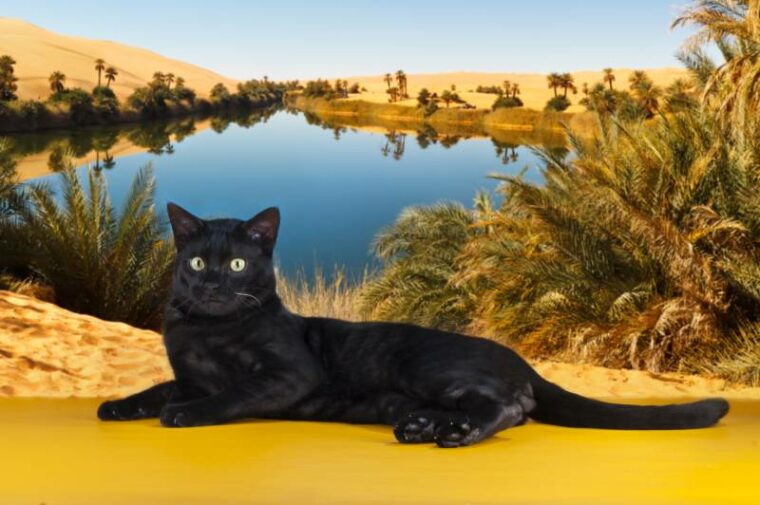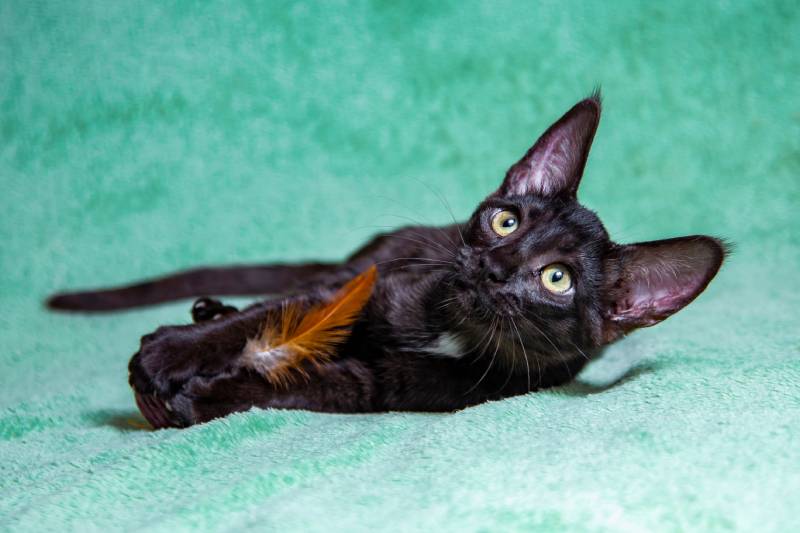
Click to Skip Ahead
Savannah Cats are generally rare, but what’s even rarer is the Black Savannah Cat. Black Savannah Cats are a type of Savannah Cat that have black coats with black spots and tail rings that are usually only visible in good lighting.
These mysterious cats are difficult to find, so consider yourself lucky if you come across one. Black Savannah Cats are a relatively new breed, so there’s still much to discover and learn about them. Here’s what we know so far about these beautiful cats.
Breed Overview
Height:
14–17 inches
Weight:
12–25 pounds
Lifespan:
12–20 years
Colors:
Black, brown spotted tabby, silver spotted tabby, black smoke
Suitable for:
Experienced cat owners, active families, single-family homes
Temperament:
Energetic, intelligent, loyal, playful
Black is a color for Savannah Cats that’s recognized by The International Cat Association (TICA)1. Other than color, Black Savannah Cats don’t have particularly distinguishable traits from Savannah Cats with other coat colors. Their temperaments don’t tend to deviate from the breed temperament, so you can expect caring for them to be similar to other Savannah Cats.
Black Savannah Cat Characteristics
The Earliest Records of the Black Savannah Cat in History
The Savannah Cat is a relatively new cat breed that’s a cross between a wild African Serval and a domestic cat. The first recorded Savannah Cat was born on April 7th, 1986. This kitten had an African Serval parent and a Siamese Cat parent, and she was given the name, “Savannah.”
After the birth of Savannah, breeders by the name of Patrick Kelley and Joyce Sroufe decided to work together to develop a new cat breed. They initiated a Savannah cat breeding program, and more breeders eventually joined the movement and helped to boost the appearance of more Savannah cats in the 1990s.

How the Black Savannah Cat Gained Popularity
Black Savannah Cats started to become popular due to their exotic looks. They were a more friendly and manageable option than exotic wild cats, like bobcats and lynxes. So, they became a sought-after option for people who wanted to care for a cat with an exotic appearance but didn’t have the means, resources, and experience to care for an actual wild cat.
Many people are also drawn to rare pets. It is already difficult to breed Savannah Cats because African Servals and domestic cats have different breeding seasons and mating behaviors. On top of that, Black Savannah Cats are even rarer because their coat type is caused by an uncontrollable gene mutation. So, they became more popular as they’re more difficult to produce than Savannah Cats with the typical brown and black spotted tabby coats.
Formal Recognition of the Black Savannah Cat
Breeders Kelley and Sroufe began the movement of establishing breeding programs for Savannah Cats, and they developed the breed standards that are used by The International Cat Association (TICA) today. More Savannah Cat litters started appearing in the 1990s, and TICA eventually accepted them for registration in 2001. Savannah Cats recently received Championship status in 2012, and the black coat is an accepted color that’s listed in the breed standards.
A non-profit organization by the name of the Savannah Cat Association was created to protect and preserve the breed and provide education to the public2. This association also provides information on ethical breeding practices and has a registry of reputable and vetted Savannah Cat breeders.
Top 3 Unique Facts About the Black Savannah Cat
1. There are several generations of Black Savannah Cats
Breeders often breed different generations of Black Savannah Cats. You can tell the generation of a Black Savannah Cat by the prefix of the letter F and then a number following it. For example, if you see an F1 Black Savannah Cat, it means that this cat has one African Serval parent and one domestic cat parent. An F2 Black Savannah Cat has an African Serval grandparent.
As you move down the generations, the Black Savannah Cats will have less African serval in their DNA. Black Savannah Cats also tend to get smaller as you go further down the generations. They tend to adopt more docile and friendly personalities due to having a higher percentage of domestic cat in their genetic makeup.
2. Black Savannah Cats get their coat color from a recessive gene mutation
Black Savannah Cats are especially difficult to breed because their coat color comes from a genetic mutation. This gene mutation is often referred to as melanism. It causes the overproduction of melanin, which causes a darker coat color. This is why Black Savannah Cats are also known as Melanistic Savannah Cats.
3. Black Savannah Cats are illegal to keep as pets in certain states
Some states don’t allow F1 and F2 Black Savannah Cats as pets:
Other states may allow F1 Black Savannah Cats if you obtain a permit. Most states will allow Black Savannah Cats to live in homes as pets if they’re in the F4 generation and later generations.
While each state has its own rules on permitting Black Savannah Cats as pets, local municipalities may have more specific and stricter rules. For example, the state may allow the care of Black Savannah Cats as pets, but a county within the state still may not allow them in its neighborhoods. So, it is important to check with your local municipality before bringing home a Black Savannah Cat.
 Does the Black Savannah Cat Make a Good Pet?
Does the Black Savannah Cat Make a Good Pet?
Black Savannah Cats can be wonderful pets. They’re known to be loyal to their families without being too shy or aloof around strangers. These cats can grow to large sizes and be highly active, so they’re best suited for experienced cat owners. They’re very intelligent and get bored easily. So, if they don’t have healthy outlets to let out their energy, they can quickly get into trouble and get into your cupboards and pantry and destroy furniture.
Because of their large size and energy, Black Savannah Cats tend to do best in single-family homes with ample amounts of space. Smaller Black Savannah Cats of later generations usually have an easier time adjusting to apartment life.
Conclusion
Overall, Black Savannah Cats are beautiful and mysterious. They come in several different generations, and their temperaments may vary based on which generation they’re in.
If you’re interested in bringing home a Black Savannah Cat and have experience with caring for cats and understanding their behaviors, you may want to consider bringing home an F1 or F2 Black Savannah Cat. If you’re a new cat owner, an F4 or later generation of Black Savannah Cats is probably a better fit for you. These cats are truly wonderful and unique, and they deserve the respect and adequate care that ensure that they live long and happy lives.
Featured Image Credit: kuban_girl, Shutterstock






